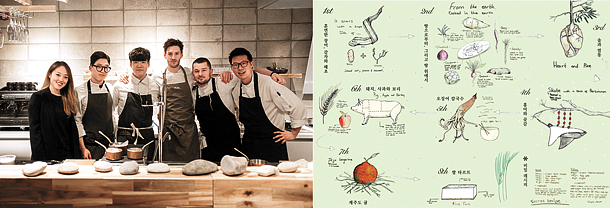A new approach to Korean cuisine

Left: Chef Joseph Lidgerwood, third from right, poses with other chefs who worked at a pop-up dinner last month. Right: Lidgerwood provides a menu complete with drawings of the ingredients to diners after the dinners. [JOSEPH LIDGERWOOD]
Instead of stressing his Australian background, he has taken a leap to show off his own rendition of Korean cuisine. Since last month, the chef has organized two pop-up dinners, one in southern Seoul and one north of the Han River, to open up a chance for locals to taste his variations of food cooked with Korean ingredients, as he has become more and more interested in Korean food after his first visit last summer.
He was part of a group of chefs that traveled to different countries to study local ingredients and hold pop-up dinners in the United States, Hong Kong, Japan, China, Thailand, Vietnam and more. He continued after his visit to Korea, but decided to leave the group after Nepal to come back to Korea to focus on what’s available here.
“I thought [Korea] was the most undiscovered,” said Lidgerwood in an interview with the Korea JoongAng Daily, adding that he had heard so little about Korean ingredients such as doenjang (fermented bean paste) or gotgam (dried persimmon) when he was working at The Ledbury, a Michelin-starred restaurant in London, among other places, which made him want to stay.
“I wanted to use time to see what I can do here and to see if it’s worthwhile to set up here for long term.” And after a few months spent in Korea, he is now sure that he wants to stay here long term and open a restaurant that has a more progressive approach.
To find his own style of making what can be identified as Korean food, he continues to do pop-up dinners with the help of local chefs and sommeliers. This past Sunday, he prepared dishes with sea squirt to refresh the palate and moved on to pair locally grown kohlrabi and mackerel. He also used different types of root vegetables including naengi, one of the most loved spring vegetables in Korea for its sweet taste, along with doraji and sweet potato, and even used a combination of ginseng and bee pollen to serve after the main dish of duck for the dinner held at Vatos in Itaewon.
Behind the scenes, helping Lidgerwood realize his idea of Korean cuisine are local chefs and sommeliers. Courses have been paired with Korean liquors available on the market or made by Korean liquor sommelier Chun Jisung of The Sool Gallery, a small liquor museum located near Gangnam Station in southern Seoul. Chef Kim Bong-su of 21st Century Seoul, a Korean restaurant in Yongsan District, central Seoul, has been setting Lidgerwood up with other Korean food experts so that what’s been commonly shared among locals can be spread to the eyes and hands of the Australian chef in an attempt to create Korean cuisine worth exploring and approachable.
Although not confirmed, he is working now to host more dinners while he stays in Korea before going to California to master his skills and hone his philosophy on life in the kitchen at French Laundry, run by legendary American chef Thomas Keller. Lidgerwood said he wants to do more intimate, small size dinners with a maximum of 15 diners at a time.
For updates on his pop-up schedule in Korea, go to www.facebook.com/JosephsKorea.
BY LEE SUN-MIN [summerlee@joongang.co.kr]










with the Korea JoongAng Daily
To write comments, please log in to one of the accounts.
Standards Board Policy (0/250자)